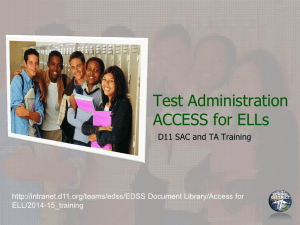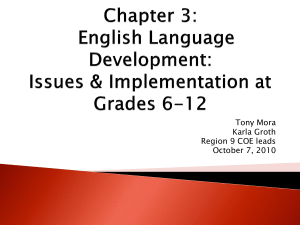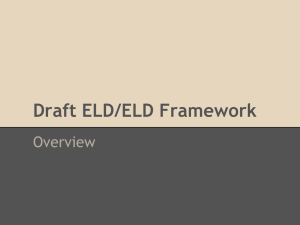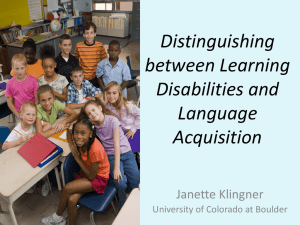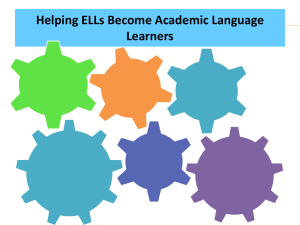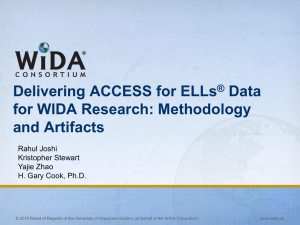1. Enhancing Instruction by Incorporating the WIDA ELD Standards
advertisement
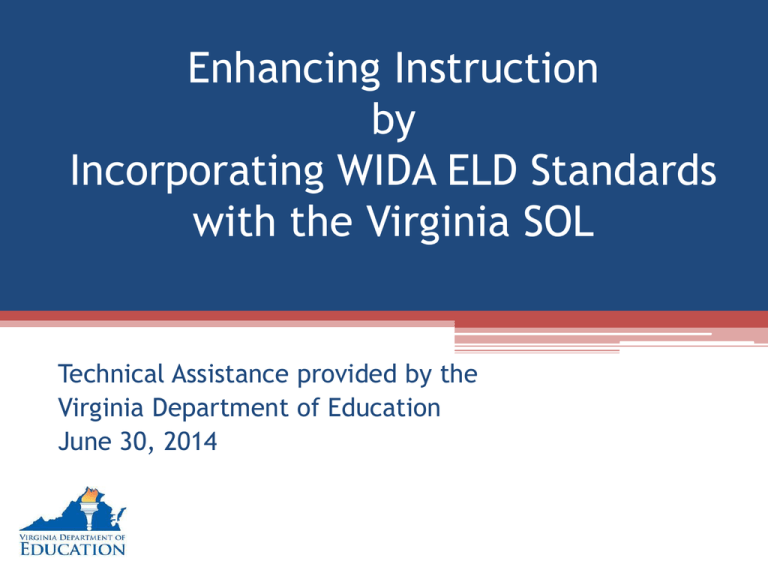
Enhancing Instruction by Incorporating WIDA ELD Standards with the Virginia SOL Technical Assistance provided by the Virginia Department of Education June 30, 2014 2 Today’s Highlights include… • Demographics/Terminology • Changing Role of the ESL Educator • WIDA ELD Standards 3 Demographics (Based upon September 30, 2013, Student Record Collection) 4 ELL Growth 349% over the past 15 years 100,000 90,000 80,000 70,000 60,000 50,000 40,000 30,000 20,000 10,000 0 1998 2001 2003 2006 2009 2012 2013 (26,525) (43,535) (60,990) (78,216) (86,751) (92,420) (92,457) 5 Divisionwide ELL Distribution 50 45 40 35 30 25 20 15 10 5 0 Largest ELL Student Enrollment 40,000 35,000 30,000 25,000 20,000 15,000 10,000 5,000 0 Top 10 Divisions Largest Percentage of ELL Students (Compared to ALL Student Enrollment) Top 10 Divisions 35% 30% 25% 20% 15% 10% 5% 0% 8 Number of Languages Reported in Virginia Schools 214 9 Top Ten Languages 70,000 60,000 50,000 40,000 30,000 20,000 10,000 0 10 Terminology 11 Acronym Clarification • The student ▫ ▫ ▫ ▫ LEP: Limited English Proficient (NCLB) ELL: English language learner (ESEA) EL: English Learner (ESEA) FLEP: Formerly LEP (NCLB & ESEA) • The teacher/program ▫ ESL: English as a Second Language ▫ ESOL: English for Speakers of Other Languages 12 Know your ELL students… 13 ELLs may be… • • • • • • • • • LT-ELLs: R-ELLs: M-ELLs: SIFE: Long Term ELLs Reclassified ELLs Migrant ELLs Students with Interrupted Formal Education SE-ELLs: Special Education ELLs Newcomers: Refugees, Immigrants HSN: Highly Schooled Newcomers Struggling Readers Gifted and Talented Margarita Calderón & Associates, Inc. 14 Guidelines for Determining K-12 WIDA ELP Levels (Instructional Levels) WIDA® ELP Levels ACCESS for ELLs® Scores Level 1 Composite Score of 1.0 through 1.9 Level 2 Composite Score of 2.0 through 2.9 Level 3 Composite Score of 3.0 through 3.9 Level 4 Composite Score of 4.0 through 4.9 Level 5 Composite Score of 5.0 through 6.0 and a Literacy Score less than 5.0 15 Guidelines for Determining K-12 WIDA ELP Levels Formerly LEP (Monitored Levels) WIDA® ELP Levels Level 6 Year 1 (Formerly LEP) ACCESS for ELLs® Scores For kindergarten students: Accountability Proficiency Score; Composite Score of 5.0 or above; and Literacy Score of 5.0 or above. For students in Grades 1-12: Tier C; Composite Score of 5.0 or above; and Literacy Score 5.0 or above. Level 6 Year 2 (Formerly LEP) *Note: Level 6, Year 1, and Level 6, Year 2, FLEP students do not take the annual ELP assessment and are only included in the calculation for AMAO 3 (AMO) for reading/language arts and mathematics. For kindergarten students: Accountability Proficiency Score; Composite Score of 5.0 or above; and Literacy Score of 5.0 or above. For students in Grades 1-12: Tier C; Composite Score of 5.0 or above; and Literacy Score 5.0 or above. 16 TESOL Report Changing Role of the ESL Teacher • A singular focus on language acquisition independent of content learning is insufficient and ineffective. • Critical shifts in instructional practice are essential to improve ELLs’ language and content learning. • What does this shift in teaching ELLs look like? Reported by Diane Staehr Fenner: May 7, 2013 17 Quick Poll Please “vote” for the statement below that best describes you and your role, in supporting the instruction of ELLs. 1. I meet consistently with classroom teachers/EL Specialists to co-plan lessons and discuss strategies for ELLs. 2. I occasionally meet with classroom teachers/EL Specialists to co-plan lessons and discuss strategies for ELLs. 3. I rarely meet with classroom teachers/EL Specialists to co-plan lessons and discuss strategies for ELLs. 18 II. context Today, there are multiple initiatives at play that are too often treated as distinct and separate Standards of Learning Implementation of Assessments SOL and ACCESS for ELLs ELD Standards 19 Triangle of Interaction Critical Components for Effective ELL Education To ensure the best possible instruction, the pieces need to fit together in a more coherent way This requires significant cooperation among educators in a school Content and ESL teachers Academic Achievement for ELLS Adopted from Straehr Fenner and Segota, 2012 Content and ELD Standards Content and ELD Assessments 20 Framing questions • What role are educators of ELLs playing at the division or classroom level in the implementation of Standards of Learning? • How can divisions better leverage the expertise and experiences of ELL educators to plan and implement the Standards of Learning? 21 III. The changing role of the ELL educator Current Preferred Varying Roles Greater recognition for expertise and use of skills. Uneven role in leadership Greater input on programmatic/instructional decisions with ELLs in mind Language instruction in isolation Deliberate, focused collaboration with content teachers Note: Adapted from TESOL International Association (2013). . 22 Changing role: A Vision Current Preferred Varying Roles ELL Educator as expert, consultant, and advocate 23 Changing Role of ESL Educators Levels Needs Strategies Division A comprehensive effort to ensure materials and professional development incorporate the needs of ELLs into consideration 1. Equity Audit Classroom Strategies to ensure that all educators understand best practices with ELL 2. Evaluation of SOL instructional strategies for ELLs School Deliberate collaboration 3. Talking points; Modeling Note: Tool created by DSF Consulting IV. Strategies 1. Equity Audit An Equity Audit enables educators to look holistically at a school and division and assess whether steps are being taken to prepare educators to meet the needs of ELLs during the incorporation of SOLs. 24 25 Strategies: Equity Audit Considerations Questions to Ask: To What Degree… Communication Do ELL educators and classroom teachers spend time communicating about the needs of ELLs? Planning Do ELL educators have input into how language instruction is delivered in classrooms with ELLs? Instructional Materials Do ELL educators have input into how language instruction is delivered in classrooms with ELLs? Professional Development Does PD prepare all teachers for SOLs to include ELLs? Note: Tool created by DSF Consulting IV. Strategies 2. SOL for ELLs: Lesson Planning Review ELL educators and division leaders need to ensure that all teachers understand the needs of ELLs and how ELLs learn SOL content. 26 27 Strategies: Lesson Plan Review for ELLs SOL Questions to Discuss Alignment • • Regular practice with complex text and its academic language • • Reading, writing and speaking grounded in evidence from text • • Building knowledge through content-rich nonfiction • • Note: Tool created by DSF Consulting Is there clear alignment between the lessons, tasks, SOL and effective ELD practice? Is there an ELD focus integrated into instruction? Is academic language instruction woven throughout the lessons? Are there clear strategies to support ELL engagement and participation? Are text-dependent questions used that are scaffolded for ELLs? Are the four domains (speaking, listening, reading and writing) integrated throughout instruction? Is an appropriate amount of background knowledge concisely taught for ELLs? Is native language support provided for ELLs who need it? IV. Strategies 3. Talking Points A talking point is a succinct statement designed to persuade or inform and a good tool for preparing for conversations. A set of talking points will facilitate easier interaction and engagement with content teachers. 28 29 Strategies: Talking Points SOL How can I help you/I can help you: Regular practice with complex text and its academic language …analyze the academic language of the text you’re using and provide scaffolding for ELLs at different levels of English proficiency so they can access the academic language. Regular practice with complex text and its academic language ...integrate the four domains into instruction and write text-dependent questions that are scaffolded for ELLs. Building knowledge through content-rich nonfiction …determine an appropriate amount of concise background knowledge to teach ELLs so they are better positioned to access informational text. Note: Tool created by DSF Consulting IV. Strategies 4. Modeling Modeling is a way to show or demonstrate instructional strategies for ELLs in the classroom setting instead of describing them. 30 31 Strategies: ELL Educators’ Modeling Meet with the content teacher prior to plan (review lesson plan) Choose one or two strategies to model Debrief Observe ELLs as they take part in co-taught lessons Note which ELLs respond best to which strategies Have content teacher note what worked well and what did not Note: Tool created by DSF Consulting 32 WIDA (World-Class Instructional Design and Assessment) ELD (English Language Development) Standards ESEA Requirement • Section 3113 (b)(2) of the Elementary and Secondary Education Act of 1965 (ESEA), as amended by the No Child Left Behind Act of 2001 (NCLB), requires state agencies to establish standards and objectives for raising the level of English proficiency in the four recognized domains of speaking, listening, reading, and writing, and that are aligned with achievement of the challenging state academic content and student academic achievement standards. 34 Where is WIDA? 35 WIDA states and territories represent over 1.2 million ELLs. Virginia represents over 92,000 ELs, 4th largest in the consortium. The EL enrollment in Virginia is approximately 7% of ALL student enrollment. 35 Mission WIDA advances academic language development and academic achievement for linguistically diverse students …through high quality standards, assessments, research, and professional development for educators. 36 WIDA Departments Operations Education Resources and Technology Professional Development Research Communications and Business Development 37 Dedicated to Professional Learning 38 What WIDA Research Says… Train Educators of ELLs Standards in Classrooms Assess 39 Making the WIDA Standards more explicit… WIDA ELD Standards Social & Instructional Language Language of Language Arts Language of Mathematics Figure A pg. 3 Language of Science Language of Social Studies Academic Language Standard 1 Standard 2 Standard 3 Standard 4 Standard 5 Language Domains Listening Process, understand, interpret and evaluate spoken language in a variety of situations Speaking Engage in oral communication in a variety of situations for a variety of purposes and audiences Reading Process, understand, interpret and evaluate written language, symbols and text with understanding and fluency Writing Engage in written communication in a variety of situations for a variety of purposes and audiences Levels of English Language Proficiency • Instructional Levels:1-5 • Monitoring Level:6 (for two years after meeting Level 5 exit criteria) 5 4 3 2 1 ENTERING EMERGING DEVELOPING EXPANDING BRIDGING 6 R E A C H I N G WIDA Framework 44 Figure F pg. 7 Performance Definitions (Two sets) • Receptive language (listening and reading) How ELLs process language to comprehend information, ideas, or concepts in either oral or written communication • Productive language (speaking and writing) How ELLs produce language to express information, ideas, or concepts in either oral or written communication 46 Figure G pg. 8 WIDA Performance Definitions – Grades K-12 Listening and Reading (receptive language) 47 Figure H pg. 9 WIDA Performance Definitions - Grades K-12 Speaking and Writing (productive language) 48 Standards Connection Grade: 5 Standard: The Language of Mathematics Connection Example Topic Topical Vocabulary: Students at all levels of English language proficiency are exposed to gradelevel words and expressions, such as: horizontal and vertical axes, coordinates, coordinate plane Level 1 Entering Level 2 Emerging Level 3 Developing Level 4 Expanding Level 5 Bridging Ask and answer yes/no questions related to coordinate plane maps using teacher oral scaffolding and visual supports Ask and answer simple whquestions related to coordinate plane maps using sentence frames and visual supports Describe the relationship between two points on coordinate plane maps using a word bank and visual support Describe the relationships among multiple points on coordinate plane maps using visual support Explain how to plot points and navigate distances between locations on coordinate plane maps Cognitive Function: Students at all levels of English language proficiency UNDERSTAND how to plot points on a coordinate plane. Example Context for Language Use: Students give directions for navigating to and from locations on the map with a partner to practice referring to axes and coordinates. Topical Vocabulary Cognitive Function Example Context for Language Use Level 6 - Reaching SPEAKING Coordinate planes Mathematics, Geometry #1-2 (Grade 5): Represent real world and mathematical problems by graphing points in the first quadrant of the coordinate plane, and interpret coordinate values of points in the context of the situation. 49 Additional Supports Available on WIDA Web site www.wida.us Instructional Supports Sensory Supports Use of Graphic Organizers Template for customizing instructional strands GRADE: _________ Additional Strands • Integrated strands • Expanded strands • Complementary strands Integrated Strands pgs . 18-19 • Show how one unit of instruction integrates all four language domains • Encourage educators to prepare units incorporating multiple language domains and subject areas • Help students make important learning connections across disciplines Listening Speaking Reading Note: Virginia History and Social Sciences is referenced as a connection. Writing Expanded Strands pgs. 24-25 • Display the features of academic language: Linguistic Complexity (Discourse Level) Language Forms & Conventions (Sentence Level) Vocabulary Usage (Word/Phrase Level) • Provide concrete examples of language at discourse, sentence, and word/phrase levels • Show how MPIs are connected to Performance Definitions • Inform teachers’ planning and instruction Complementary Strands Address language used in electives, including: • Music and Performing Arts (pgs. 51, 81, 111) • Humanities (pgs. 57, 87) • Visual Arts (pgs. 63, 93) • Health and Physical Education (pgs. 69, 99) • Technology and Engineering (pgs. 75, 105) CAN DO Descriptors • Provide teachers with information on the language students are able to understand and produce in the classroom within all five ELD standards. • Available for the following grade-level clusters: PreK-K Grade 1-2 Grades 3-5 Grades 6-8 Grades 9-12 59 Lesson Plan Share Space This is a space created for educators and by educators as a space to share ideas. 60 Search for a lesson: • • • • • Topic, title or keyword Author Language standard Grade Language domain 61 Essential Actions • A Handbook for Implementing WIDA’s Framework for English Language Development Standards ▫ A Companion to the 2012 Amplification of the ELD Standards 62 63 Resources Galore! • ELD Standards Books • Can Do Books • Focus Bulletins • Webinars • Research Reports • Sample ACCESS items • And more! 64 Making the Connection Language Proficiency Language Academic Language WIDA ELD Standards Standards of Learning Standards Academic Achievement Assessment Content Curriculum & Instruction 65 Instructional Framework Supplemental Title III services Supplemental Title I services Core Language (Lau) (ELD Standards) Core (SOLs) 66 Sample Science Lesson Plan SOL 4.4 The student will investigate and understand basic plant anatomy and life processes. Key concepts include the structures of typical plants and the function off each structure; processes and structures involved with plant reproduction; photosynthesis; and adaptations allow plants to satisfy life needs and respond to the environment. WIDA Standard 4: The language of science Linguistic Complexity (discourse level) What part of the plant _______________? The _____ part of the plant does _______________. How are plants pollinated? Plants are pollinated _______. Language Forms and Conventions (sentence level) Pollinate-pollinated Reproduce-reproducing Vocabulary Usage (word/phrase level) root, stem, leaves, flower, transport, photosynthesis, environment Differentiated Practice (Remediation): Provide the student with a flower drawn by the teacher. Have the students label it and write the function of each flower part using a word bank (created by the teacher). Finally, have the students color in the flower. Differentiated Practice (Enrichment): Have the students create their own model of a flower using modeling clay. The students can then create an index card booklet to list the parts of the flower and explain each part’s function. 67 Sample English Pacing Guide 3rd Nine Weeks 4th Nine Weeks Continue to review and expand skills from previous nine weeks and add: Continue to review and expand skills from previous nine weeks and add: SOL Usage/mechanics/grammar: Select items for review based on student needs Composing/Written Expression: Self-select narrative or expository topic for independent writing Compose persuasive papers incorporating shared writing on student and teacher selected topics Apply knowledge of writing domains Connect writing mode with the appropriate pattern of organization Edit for fragments and run-ons Use hyphens to divide words at the end of a line 5.8 SOL Writing: Writing: Usage/mechanics/grammar: Use adverbs instead of adjectives where appropriate Use conjunctions Composing/Written Expression: Research Formulate questions about a topic Identify key terms to use in searching for information Identify, locate, explore and effectively use a variety of resources Skim and select information Combine related information from two or more sources Use facts and details in sentences to elaborate the topic Use specific vocabulary, words and phrases Develop notes Give credit to sources used in research 5.8 5.7 WIDA English Language Development Standards To be incorporated within the daily delivery of instruction for ELL students. Standard Abbreviation English Language Proficiency Standard 1 English language learners communicate for Social and Instructional purposes within the school setting Social and Instructional language English Language Proficiency Standard 2 English language learners communicate information, ideas and concepts necessary for academic success in the content area of Language Arts. The language of Language Arts 5.7 68 Sample Curriculum Map SOL Standard of Learning Time Curriculum Framework Essential Knowledge Essential Vocabulary Teacher Resources & Enhanced Scope and Sequence Lessons (ESS) WIDA English Language Development Standards 1.11 *not tested until 3rd 9 weeks Measurement Calendar Language 9/3 – 9/6 4 days (ongoing) p. 18 month; today; yesterday; next week; last week; calendar Calendar Connections Standard 1: Social and Instructional Language *Use calendar language appropriately (e.g., names of the months, today, yesterday, next week, last week). 1.14 *not tested until 3rd 9 weeks Probability & Statistics Data Collection/Graphs *Investigate, identify, and describe various forms of data collection (e.g., recording daily temperature, lunch count, attendance, favorite ice cream), using tables, picture graphs, and object graphs Standard 2: Language of Language Arts Standard 3: Language of Mathematics – p. 25 data; count (ing); tally (ing); picture graph; object graph Data in our World Domains include: Listening, Speaking, Reading, Writing 69 Sample Curriculum Framework Standard 11.2 Strand: Communication: Speaking, Listening, Media Literacy 11.2 The student will examine how values and points of view are included or excluded and how media influences beliefs and behaviors. a) Use technology and other information tools to organize and display knowledge in ways others can view, use, and assess. b) Use media, visual literacy, and technology skills to create products. c) Evaluate sources including advertisements, editorials, blogs, Web sites, and other media for relationships between intent, factual content, and opinion. d) Determine the author’s purpose and intended effect on the audience for media messages. UNDERSTANDING THE STANDARD (Teacher Notes) • ESSENTIAL KNOWLEDGE, SKILLS, AND PROCESSES ESSENTIAL UNDERSTANDINGS Students will continue to develop media literacy by examining how media messages influence people’s beliefs and behaviors. All students should • recognize that media messages express viewpoints and contain values to influence the beliefs and behaviors of the intended audience. To be successful with this standard, students are expected to • organize knowledge and display learning using visual images, text, graphics, and/or music to create media messages with visual, audio, and graphic effects. ELD Standard 1: Social and Instructional Language ELD Standard 2: The Language of Language Arts Example Context for Language Use: Students listen to sample advertisements (video, radio, etc.) to assess the use of persuasive techniques in the media. COGNITIVE FUNCTION: ANALYZE LANGUAGE DOMAIN: LISTENING Level 1 Entering Listen to and match media samples to specific purposes using visuals and a bilingual dictionary and working with a partner Level 2 Emerging Listen to and label media samples with a specific purpose using a word bank and bilingual dictionary and working with a partner Level 3 Developing Listen to and categorize media samples by specific purpose working with a partner Level 4 Expanding Listen to, identify, and discuss how characteristics of media samples relate to a specific purpose working with a partner Level 5 Bridging Listen to and compare and contrast by purpose the characteristics of media samples working with a partner Level 6-Reaching TOPIC-RELATED LANGUAGE: Students at all levels of English language proficiency interact with grade-level words and expressions, such as: values, point of view, influence, belief, behavior, evaluate, advertisement, blog, editorial, intent, content, opinion, purpose, effect, audience, objectivity, subjectivity, bias, media, connotation, symbol, metaphor, imagery, visual, audio, graphic, audience, context, word choice, impact, public opinion, analyze, critique, persuade, entertain, appeal, ethics, belief Sample English Instructional Strand SOL 11.2 The student will examine how values and points of view are included or excluded and how media influences beliefs and behaviors. ELD Standard 1: Social and Instructional language ELD Standard 2: The language of Language Arts Level 1 Entering Listen to and match media samples to specific purposes using visuals and a bilingual dictionary and working with a partner Level 2 Emerging Listen to and label media samples with a specific purpose using a word bank and bilingual dictionary and working with a partner Level 3 Developing Listen to and categorize media samples by specific purpose working with a partner Level 4 Expanding Listen to, identify, and discuss how characteristics of media samples relate to a specific purpose working with a partner Level 5 Bridging Listen to and compare and contrast by purpose the characteristics of media samples working with a partner Language develops across different levels of language proficiency. Sample Mathematics Instructional Strand SOL. 5.12 The student will classify a) angles as right, acute, obtuse, or straight; and b) triangles as right, acute, obtuse, equilateral, scalene, or isosceles. ELD Standard 1: Social and Instructional language ELD Standard 2: The language of Language Arts ELD Standard 3: The language of Mathematics Level 1 Entering Level 2 Emerging Level 3 Developing Level 4 Expanding Ask and answer yes/no questions related to types of angles using teacher oral scaffolding and visual supports Ask and answer simple whquestions related to types of angles using sentence frames and visual supports Describe the relationship between types of angles using a word bank and visual support Describe the relationships among multiple angles using visual support Level 5 Bridging Explain how to classify angles with and without visual support Language develops across different levels of language proficiency. Sample Science Instructional Strand SOL 4.1 The student will demonstrate an understanding of scientific reasoning, logic, and the nature of science by planning and conducting investigations ELD Standard 1: Social and Instructional ELD Standard 2: The language of Language Arts ELD Standard 4: The language of Science Level 1 Level 2 Level 3 Entering Emerging Developing State reasons for State reason for Explain outcomes of outcomes of outcomes for experiments of experiments on experiments on electricity using electricity using electricity using illustrations and oral illustrations or realia illustrations or sentence frames and teacher realia, oral sentence guidance (i.e. starters, and “electricity goes, teacher guidance “electricity stops” (i.e. “the bulb when circuit is turned on opened or closed because…”, “the balloons attracted/repelled because…”) Level 4 Expanding Explain in detail outcomes of experiments on electricity using illustrations and with word/phrase banks Level 5 Bridging Explain in detail outcomes of experiments on electricity using illustrations or realia Language develops across different levels of language proficiency. Sample History/Social Science Instructional Strand SOL 1.6 The student will describe how the location of his/her community, climate, and physical surroundings affect the way people live, including their food, clothing, shelter, transportation, and recreation. ELD Standard 1: Social and Instructional ELD Standard 2: The language of Language Arts ELD Standard 5: The language of History/Social Science Level 1 Level 2 Level 3 Entering Emerging Developing Name weather Restate weather Describe weather conditions and their conditions and their conditions and their effects on people effects on people effects on people using calendars, using calendars, using calendars, maps, charts, and maps, charts, and maps, charts, and graphs graphs graphs Level 4 Expanding Discuss weather conditions and their effects on people using calendars, maps, charts, and graphs Level 5 Bridging Explain weather conditions and their effects on people using calendars, maps, charts, and graphs Language develops across different levels of language proficiency. 74 Building Bridges Collaboration Collaboration Professional Development Mainstream ESL Core (SOL) and Core Language (ELD Standards) Classrooms Core (SOL) and Core Language (ELD Standards) 75 How can we provide support to balance the instructional scale? Standards of Learning ELD Standards SUCCESS on SOL Assessments and ACCESS for ELLs® 76 So that ALL students including ELLs are… 77 Time to share… 1. How does your school division assure the core programs and services include core language programs and services? 2. How does your school division assure that core language programs and services include core programs and services? 3. What type of Title III supplemental support does your school division provide to 1 and 2 above? 78 Virginia Department of Education Title III Contacts Veronica Tate Director Program Administration and Accountability Veronica.Tate@doe.virginia.gov (804) 225-2870 Judy Radford ESL Coordinator Stacy Freeman Title III Specialist Judy.Radford@doe.virginia.gov Stacy.Freeman@doe.virginia.gov (804) 786-1692 (804) 371-0778 Kristi Bond Title I/Title III Specialist Christopher Kelly Education Coordinator Kristi.Bond@doe.virginia.gov Christopher.Kelly@doe.virginia.gov (804) 371-2682 (804) 225-2122

